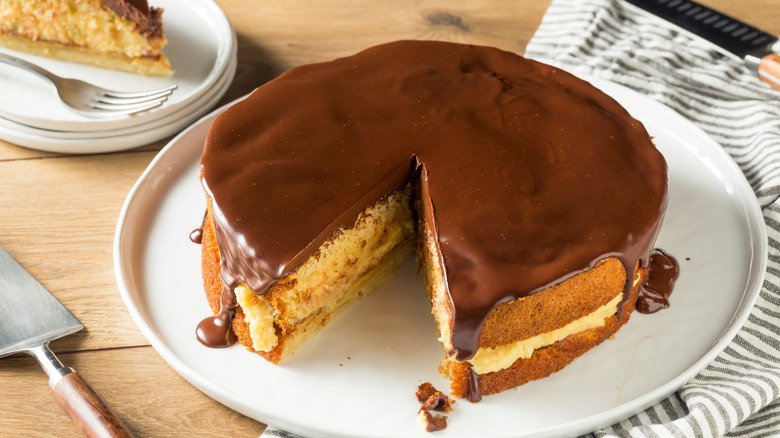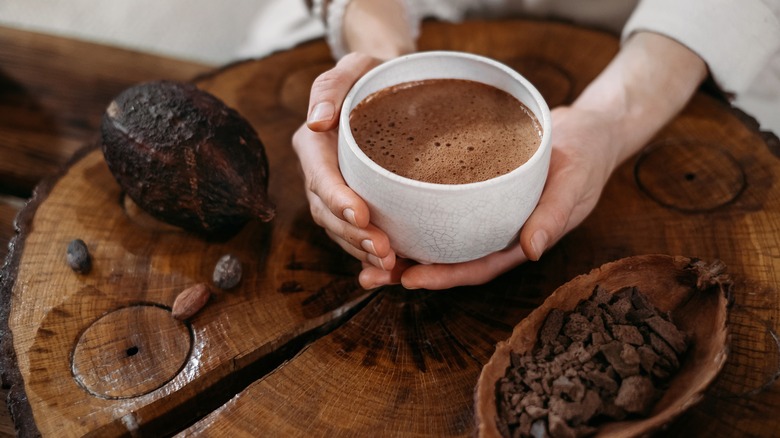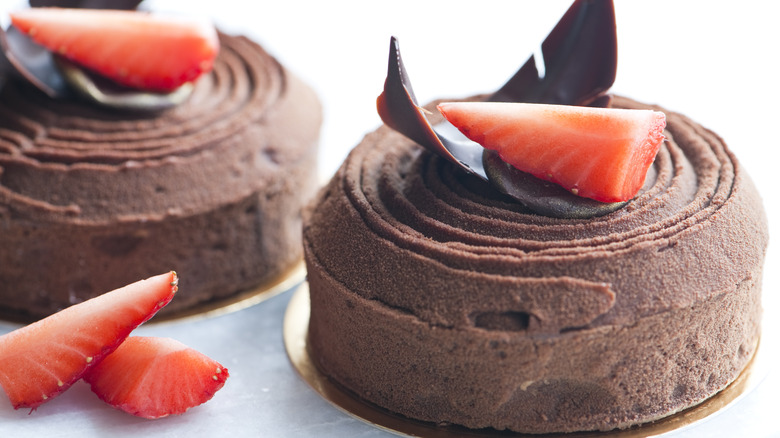Chocolate Wasn't Considered A Dessert Until Boston Cream Pie Came Along
We're living in a time when chocolate is so abundant that it can be part of anything you eat, from breakfast to snacks to dinner (think mole poblano, the signature Cinco de Mayo dish). Cocoa is a welcome ingredient, but for the most part, it is mostly associated with dessert. However, up until the mid-19th century, chocolate was something people drank in America, and was not commonly included in the last meal course. That meant no brownies, chocolate layer cakes, Rocky Road ice cream, or even chocolate chip cookies. But when a French chef named Sanzian poured glossy chocolate on top of what would later become known as today's Boston cream pie, he changed the course of desserts forever.
Boston's Parker House Hotel hired Sanzian as its pastry chef in 1855. He essentially took a traditional English cream cake, coated the sides with almonds, and glazed the top with chocolate, which set the dessert apart. Originally called Chocolate Cream Pie, it was later renamed Boston Cream Pie, which is equally curious since it's not a pie at all. The dessert consisted of two layered sponge cakes filled with vanilla pastry cream, and topped with a chocolate coating. Suddenly, Bostonians had a new way to enjoy chocolate, other than sipping it, and the ingredient slowly began to be included in other sweet recipes.
Chocolate in dessert was unusual
Chocolate first arrived on North American soil in 1641 via a Spanish ship that landed in Florida. At that time, the ingredient was still consumed the way the ancient Mayans and Aztecs had prepared it: as a beverage. It quickly became popular in the New World, and by 1682, the first American chocolate house opened in Boston. Edible, solid chocolate wouldn't appear until nearly 200 years later, but even then, it wasn't hugely popular, as the texture was gritty, coarse, and nothing like the smooth, melty chocolate bars we know today. Because of this, it was better suited for drinking.
Sanzian likely gave many people in the Boston area their first taste of chocolate that wasn't in liquid form. Regardless, visitors to the Parker House Hotel adored his chocolate-kissed creation. As more Americans were introduced to chocolate, European chocolatiers were already finding ways to turn cocoa into different forms. In 1847, a British chocolate company named J.S. Fry and Sons created the first chocolate bar, but it was Swiss chocolatier Rudolf Lindt who invented the conch machine in 1879, which would churn chocolate into a creamy, silky consistency. Indeed, with a legacy like this, it's no surprise that Switzerland is the country that eats the most chocolate.
By 1886, chocolate was being utilized as an ingredient in other sweet recipes in America. During this year, a recipe for Mahogany Cake (known as the first chocolate cake) was printed in "The Philadelphia Cookbook."
Chocolate cake and beyond
By the late 19th century and into the 20th century, chocolate had made its sweet mark on taste buds all over America and, indeed, the world. During this time, companies like Cadbury, Mars, and Hershey were pumping out chocolate confections at an impressive rate to keep up with demand. Naturally, chocolate dessert recipes began to grow as quickly as Violet Beauregarde expanded into a blueberry in Willy Wonka's factory.
The classic chocolate brownie is said to have been invented in 1893 at the Palmer House Hotel in Chicago. Ruth Wakefield developed the iconic chocolate chip cookie in 1938, and in 1926, Hershey began marketing its chocolate syrup, which became a staple at pharmacy soda fountain counters, and eventually in ice cream shops everywhere.
The grossly-named Mississippi Mud Pie wasn't invented until the 1970s, but became a very well-known and enjoyed dessert, and chocolate lava cakes hit their stride in the 1980s. Even today, pastry chefs all over the globe continue to treat chocolate as an absolutely essential ingredient, one that people constantly look to end their meal with. And to think, without that fateful invention of Sanzian's Boston Cream Pie, all of this may never have been.



